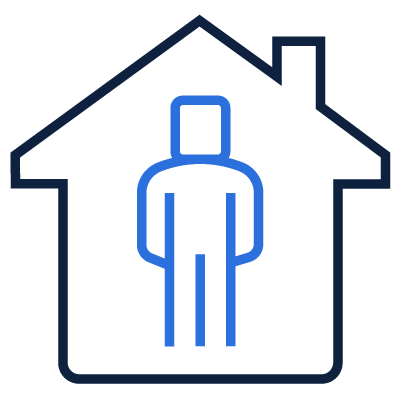
42%
of women and
23%
of men over 75 live alone
Source: Historical Living Arrangements of Adults, US Census Bureau, November 2024
As aging adults enter the fourth phase of retirement—what the MIT AgeLab calls the Solo Journey Phase—many find themselves navigating life on their own. Adjusting to living alone often means exploring new activities and experiences. Some will be big wins, others might not work out. But with a resilient mindset and a little planning, retirees can adapt and even enjoy this stage of life.
First, What’s the Solo Journey Phase?
The MIT AgeLab calls the last period of retirement “The Solo Journey Phase.” As the title implies, many retirees begin this phase by themselves. And there are lots of retirees in this phase. In 2023, 42% of women and 23% of men over 75 were living by themselves.1
Since most retirees don’t plan for this stage, it can feel daunting—and sometimes lonely. Loneliness isn’t just emotional—it can harm health as much as smoking 15 cigarettes a day. It can shorten life expectancy more than obesity or physical inactivity.2
But this phase doesn’t have to mean isolation. With an open mind and awareness of available resources, retirees can rediscover purpose, build social connections, and even reinvent themselves. This is especially true for those who spent years caring for a spouse or loved one—now is a chance to focus on their own well-being.
Second, Why Does This Phase Happen?
So how do people end up in the solo journey phase? One reason is obvious—when a spouse dies, the surviving partner enters this stage. But that’s not the only factor. Gray divorce—when couples over 50 decide to split—is becoming more common. In fact, the divorce rate for this age group has doubled over the past 30 years, and for those over 65, it has tripled.3
Many aging adults enter this phase with fewer or no children. Baby boomers had fewer children than previous generations, and about 22% of people ages 60–69 don’t have children at all.4 Even when children exist, they may live far away, leaving parents without nearby family support.
Health challenges can also cause people to enter the solo journey phase. A broken hip can wipe out your mobility, meaning you could be stuck at home and not able to go out and spend time with friends or family. Or a close friend could break a hip, meaning they won’t be able to go out and have fun with you. Hearing loss can also contribute to spending time alone.
If people can’t hear well, understanding conversations can be difficult and frustrating—so they might withdraw socially, avoiding spending time with people or participating in group activities.
Third, How to Thrive in the Solo Journey Phase
Just because retirees enter this phase alone, doesn’t mean they have to be lonely or even remain alone. To avoid isolation, you or your loved one will need to make an effort to find opportunities to spend time with others. One way to do that is by volunteering. Find a cause (aarp.org/volunteer) you care about and sign up to help.
Museums, hospitals, churches, animal shelters, and schools are always looking for people to help out. Scientists have found that seniors who regularly volunteer have a lower risk of heart disease and live significantly longer than those who don’t. Plus, you’ll likely meet others who share similar interests.
Apps can also make finding companionship easier. Stitch is an app that helps aging adults find companionship, and it’s not only about dating. Stitch promotes the idea of getting together in groups. Whether it’s a new movie, exhibit, or just dinner, they make it easy to meet others in a group setting.
Meetup is another way to meet other people in your area with similar interests through online or in-person events. Pick a category you’re interested in and Meetup will let you know of any local events that are taking place. Plus, if you’re not sure what you’re interested in, Meetup offers a wide variety of group events on topics such as outdoor adventures, technology, health and wellness, photography, cooking, hobbies and crafts, and many more. In essence, this app can help you meet new people, learn new things, find support, get out of your comfort zone, and pursue your passions.









